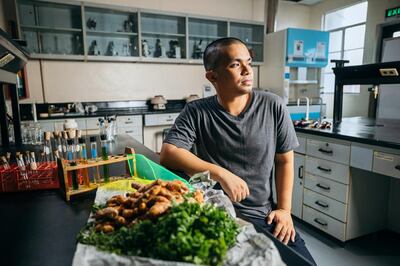A student from the Philippines has found a way to convert discarded fruits and vegetables into energy.
Carvey Maigue, from Mapua University in Manila, created a new material that absorbs ultraviolet light from the Sun and converts it into renewable energy.
Mr Maigue won the first sustainability gong in this year's James Dyson engineering awards for the innovation called Aureus.
Made from waste crops, the malleable material is not limited like traditional solar panels that must face the Sun to be effective.
It can be attached as panels to windows and walls and generates electricity whether the sun is shining or hidden behind clouds.
Mr Maigue, 27, researched ultraviolet light when he noticed drink glasses glowing in a bar and the lenses of his sunglasses darkening on a cloudy day.
“I understood that even when it is cloudy and rainy, ultraviolet light still reaches us. Conventional solar panels can’t absorb ultraviolet light and that is what my invention provides a solution for,” Mr Maigue said.
“It differs from typical solar panels due to its ability to also capture ultraviolet light even if it is not facing the Sun. Even if it is cloudy, even if it is raining, it can still capture and generate electricity. I focused on solar energy because it is a resource that is all around us.”
Early testing shows that Aureus has the potential to produce electricity 48 per cent of the time, compared with 10 per cent to 25 per cent from conventional photovoltaic cells.
The electrical engineering student experimented with 80 waste crops and narrowed it down to nine varieties that showed long-term potential.
Our first ever Sustainability Winner is AuREUS, a material made from up-cycled crop waste that can be attached to pre-existing structures to convert UV light into electricity. https://t.co/TER3RINjST
— James Dyson Award (@JamesDysonAward) November 19, 2020
The ultraviolet light is absorbed and harvested by luminescent particles in the new material that is derived from fruit and vegetables. This causes the particles to glow and the visible light is transformed into electricity.
“One of the most important components of my invention is sourced from waste produce,” he said.
“Organic luminescent compounds are derived from fruit and vegetables. These compounds turn high energy ultraviolet waves into visible light. I use solar panels and solar films to convert this light into electricity.”
Mr Maigue is already planning further use for the material and is looking to embed it in fabrics, clothes, cars, boats and entire buildings.
He participated in the 2018 awards but failed to make it to the national stage. Then, his invention could be applied only to windows and used a chemical compound as its main ingredient.
Two years later, he took another shot at the awards after intensive research and using waste crops.
“Aureus is impressive in the way it makes sustainable use of waste crops but I’m particularly impressed by Carvey’s resolve and determination,” said James Dyson, the British inventor and founder of the eponymous technology company.
“Carvey’s invention demonstrates a convincing way to create clean energy on existing structures, like windows, within cities.”
Mr Maigue is preparing to submit patents by the end of the year and has been approached by start-ups in the waste management and agricultural industries.
The other winner was Judit Benet, 23, a biomedical engineering graduate from the University of Barcelona. She took the Dyson international prize for her low-cost device that can be used at home to detect breast cancer by analysing urine.
Ms Benet’s mother’s breast cancer diagnosis spurred her to find an easier screening process.
The current procedure is invasive and women must go to hospitals or medical facilities for screening, which often causes them to skip testing and results in late detection and reduced chances of survival.
Her device, named the Blue Box, performs a chemical analysis of urine samples using artificial intelligence and provides the user with a quick diagnosis. It is linked to an online application that puts the person in touch with a medical professional if a sample tests positive.
Her team is working on a prototype and software at the University of California Irvine to get it ready for human studies and clinical trials.
“The Blue Box has the potential to make cancer screening a part of daily life. It can help to change the way society fights breast cancer to ensure that more women can avoid an advanced diagnosis,” she said.
Both winners received £30,000 ($39,615) each.
The award has financially supported about 250 young scientists globally and encourages them to design winning solutions to real-life problems using technology.
Entries will open in March 2021 for the next award and candidates can enter the competition via the James Dyson award website







